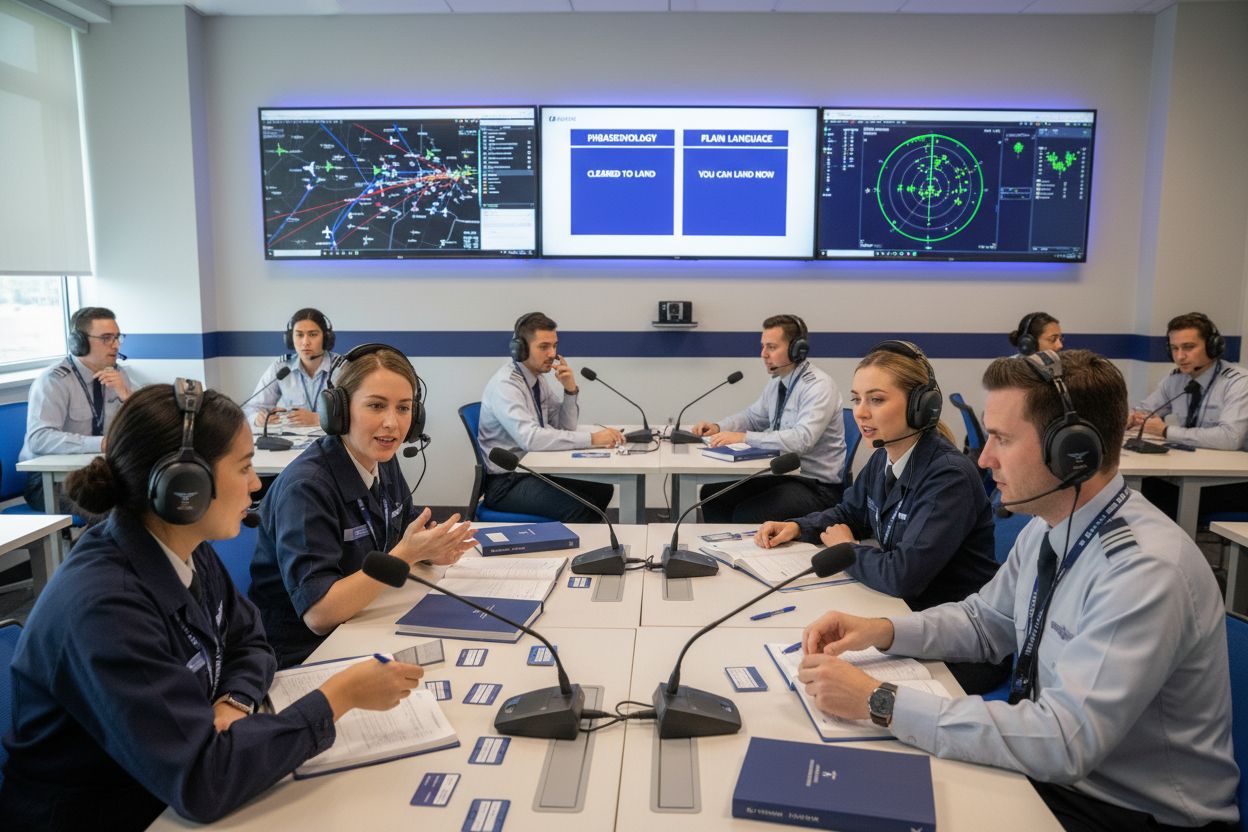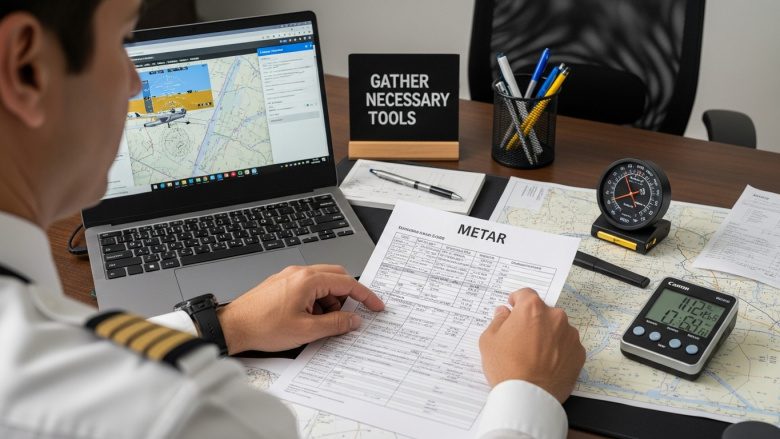Every year, miscommunication in aviation contributes to hundreds of safety incidents worldwide. The stakes could not be higher when lives depend on every word exchanged between pilots and air traffic controllers. Mastering aviation technical English is more than learning new vocabulary. It is about understanding subtle differences in phraseology, adapting instantly to unexpected situations, and meeting rigorous international standards. The right communication skills can mean the difference between routine operations and critical errors.
Key Takeaways
| Point | Details |
| Aviation Technical English | A specialized communication form essential for clear and effective interactions in the aviation sector, combining standardized phraseology and adaptable strategies. |
| ICAO and EASA Standards | Stringent language proficiency levels required for aviation personnel to ensure safety, particularly focusing on clear pronunciation, vocabulary, and interaction skills. |
| Communication Modes | Mastery of both standard phraseology and plain language is critical for addressing routine and emergency scenarios accurately in aviation contexts. |
| Proficiency Testing | Comprehensive assessments evaluate aviation-specific language skills, emphasizing real-world communication effectiveness over traditional language testing approaches. |
Table of Contents
What Is Aviation Technical English
Aviation Technical English is a highly specialised form of communication designed specifically for the complex and safety-critical world of aviation. Unlike standard English, it requires precise linguistic skills that go far beyond typical conversational language. Technical aviation English encompasses a unique blend of standardised phraseology and adaptable communication strategies essential for safe and effective interactions in aviation environments.
According to EASA documentation, technical aviation English assessment focuses on three critical dimensions:
-
Listening comprehension in aviation contexts
-
Speaking abilities specific to aviation tasks
-
Interaction skills that enable quick, accurate communication
A key distinguishing feature of aviation technical English is the ability to seamlessly transition between standard international phraseology and plain language. ICAO documentation emphasises that pilots and air traffic controllers must demonstrate linguistic flexibility, ensuring clear communication under varying operational conditions. This means understanding and using precise technical terminology while also being able to explain complex situations in straightforward language when standard phrases are insufficient.
The fundamental goal of aviation technical English is unambiguous communication. Miscommunication in aviation can have catastrophic consequences, which is why international bodies like EASA and ICAO have developed rigorous language proficiency standards. Professionals must demonstrate not just grammatical accuracy, but the ability to communicate effectively in high-stress, fast-changing scenarios where split-second understanding can mean the difference between safety and potential disaster. For those preparing for aviation language certifications, mastering this specialised form of communication is not just a requirement—it’s a critical professional skill.

ICAO And EASA Language Requirements
The International Civil Aviation Organization (ICAO) and the European Union Aviation Safety Agency (EASA) have established comprehensive language proficiency standards to ensure safe and effective communication in aviation environments. EASA Regulation (EU) No 139/2014 mandates that critical aviation personnel achieve a minimum operational language proficiency level to guarantee the highest standards of safety and communication.
Key personnel required to meet these stringent language requirements include:
-
Flight crew members
-
Air traffic controllers
-
Aerodrome vehicle drivers
-
Operational communication personnel
The cornerstone of these requirements is the ICAO Operational Level 4 proficiency standard. This level ensures that aviation professionals can communicate effectively in both routine and potentially complex scenarios. According to EASA regulations, professionals must demonstrate:
-
Clear pronunciation
-
Grammatical structure comprehension
-
Vocabulary specific to aviation contexts
-
Ability to understand and respond to linguistic challenges
Interestingly, EASA regulations have introduced a phased implementation approach. For instance, aerodrome vehicle drivers have a deferred applicability period for English language requirements, with full implementation set for January 2026. This strategic approach allows organizations and individuals time to develop and refine their language skills while maintaining rigorous safety standards. For professionals preparing for aviation language certifications, understanding these nuanced requirements is crucial for career progression and operational excellence.
Differences: Phraseology Vs Plain Language
Aviation communication is a nuanced system that relies on two distinct yet interconnected language modes: standard phraseology and plain language. While they might seem similar, these communication approaches serve fundamentally different purposes in ensuring aviation safety and clarity.
Standard phraseology is a predetermined, precise set of communication protocols designed for routine operational scenarios. EASA’s updated Easy Access Rules emphasize these standardized radiotelephony phrases as critical for consistent, unambiguous communication. Key characteristics include:
-
Highly structured linguistic patterns
-
Minimal room for misinterpretation
-
Specific word sequences for predictable situations
-
Universal understanding across international aviation contexts
Plain language, in contrast, provides flexibility for complex, non-standard, or emergency communications. EASA’s assessment guidance specifically requires aviation professionals to demonstrate the ability to seamlessly transition between phraseology and plain language. This skill is crucial when:
-
Explaining unusual circumstances
-
Providing detailed contextual information
-
Addressing unexpected operational challenges
-
Communicating nuanced or complex scenarios beyond standard protocols
The true mastery of aviation communication lies in knowing precisely when to use each language mode. For professionals preparing for aviation language certifications, understanding these subtle yet critical distinctions is not just a technical requirement—it’s a fundamental safety skill that can mean the difference between clarity and confusion in high-stakes aviation environments.
Here’s a summary of the main differences between standard phraseology and plain language in aviation communication:
| Aspect | Standard Phraseology | Plain Language |
| Purpose | Routine, predictable scenarios | Non-standard, complex situations |
| Structure | Highly structured Fixed phrase sets |
Flexible Adapts to context |
| Clarity | Minimises ambiguity | Explains details or emergencies |
| Use Cases | Regular ATC instructions Taxi clearance |
Emergency situations Unexpected events |
| ICAO/EASA Emphasis | Universal understanding | Communication in unforeseen events |
Aviation Proficiency Testing Options
Aviation English proficiency testing is a sophisticated assessment process designed to evaluate an individual’s ability to communicate effectively in high-stakes aviation environments. ICAO documentation provides comprehensive guidelines for designing and implementing these critical evaluations, ensuring global standardization of language skills across aviation professionals.
The core components of aviation proficiency testing typically include:
-
Listening comprehension
-
Speaking assessment
-
Pronunciation evaluation
-
Structural language analysis
-
Interactive communication skills
According to EASA’s AMC2 ADR.OPS.B.029(e), the testing framework is meticulously structured to assess multiple linguistic dimensions. Professionals are evaluated on their ability to:
-
Communicate clearly in routine operational scenarios
-
Handle complex and unexpected communication challenges
-
Demonstrate precise technical vocabulary
-
Exhibit fluent and coherent language skills
Testing options range from standardized international examinations to organization-specific assessments. These evaluations go beyond traditional language tests, focusing on practical communication abilities in real-world aviation contexts. For those preparing for their language certification, understanding the nuanced requirements and developing effective study techniques can significantly improve performance and professional readiness. The ultimate goal remains ensuring unambiguous, safe communication in the dynamic and safety-critical world of aviation.
Preparing For Aviation English Tests
Effective preparation for aviation English tests requires a strategic and comprehensive approach that goes beyond traditional language learning. EASA recommends utilizing ICAO’s comprehensive documentation, particularly Doc 9835 and Doc 10197, as foundational resources for developing robust examination readiness strategies.
Key preparation areas include:
-
Developing precise aviation-specific vocabulary
-
Practicing standard phraseology
-
Improving communication flexibility
-
Enhancing technical language comprehension
-
Simulating realistic aviation communication scenarios
EASA’s compliance guidance emphasizes comprehensive skill development across multiple linguistic dimensions. Candidates should focus on:
-
Pronunciation clarity
-
Grammatical structure proficiency
-
Fluent and coherent communication
-
Quick language mode switching between technical phraseology and plain language
-
Handling complex operational communication challenges
Mastering aviation English requires dedicated practice and targeted preparation. Successful candidates typically invest significant time in understanding not just language mechanics, but the contextual nuances of aviation communication. Immersing yourself in realistic scenarios, listening to professional radio communications, and practicing with experienced aviation language instructors can dramatically improve your test performance and professional communication skills.
Ready to Master Aviation Technical English with Confidence?
Understanding the difference between precise phraseology and flexible plain language is crucial for pilots and aviation professionals aiming to meet the complex demands of modern airspace. Many find themselves stressed by the high standards set for ICAO and EASA language requirements. Whether it is the fear of miscommunication during technical scenarios or the anxiety of not passing mandatory proficiency exams, these challenges can hold back your aviation ambitions.
Take the first step towards overcoming these obstacles and transforming your communication skills with the expert-led training at our Academy – VictorOne.

Achieve certification and boost your confidence with VictorOne’s online courses. Enjoy fully flexible study, interactive theory, and up-to-date exam preparation resources designed around real aviation challenges. Prepare now and secure your progress in the global aviation industry.
Explore all learning opportunities at VictorOne.eu and set your career on the path to success.
Frequently Asked Questions
What is Aviation Technical English?
Aviation Technical English is a specialized form of communication designed for the aviation industry, focusing on precise linguistic skills necessary for safe and effective interactions in complex aviation environments.
What are the key components of aviation proficiency testing?
Aviation proficiency testing typically includes listening comprehension, speaking assessment, pronunciation evaluation, structural language analysis, and interactive communication skills, all essential for effective communication in high-stakes situations.
How do standard phraseology and plain language differ in aviation communication?
Standard phraseology is a fixed set of communication protocols for routine scenarios, whereas plain language allows flexibility for complex or emergency communications, emphasizing the need for clarity in various situations.
What are the ICAO and EASA language requirements for aviation professionals?
ICAO and EASA require aviation personnel, such as flight crew and air traffic controllers, to achieve a minimum operational language proficiency level (ICAO Operational Level 4) to ensure effective communication and safety in aviation operations.


